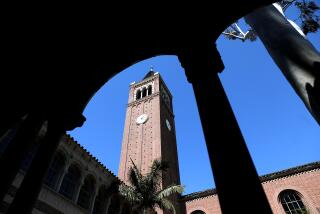In defense of affirmative action
- Share via
For 40 years, competitive colleges and universities in the United States have taken race into account in order to increase their enrollment of African Americans (and, to a lesser extent, other minorities). Originally justified as a way to compensate for a long legacy of racial discrimination, and later embraced as a way to provide a more diverse learning environment, affirmative action has been good for the United States. It has made it easier for minorities to enter the educational and professional mainstream without compromising the rigor of American higher education. It has promoted the broader cause of racial integration. And it has encouraged the emergence of a black and Latino middle class.
Those accomplishments may now be in jeopardy. This week the Supreme Court, which twice has upheld the constitutionality of some racial preferences in university admissions, agreed to hear a challenge to the University of Texas’ use of race as one factor in a “holistic” admissions policy. This comes nine years after the court, in an opinion by Justice Sandra Day O’Connor, ruled that it was constitutional for the University of Michigan Law School to pursue a similar policy in pursuit of a “critical mass” of minority enrollment necessary to promote a wide exchange of views in the classroom. But since then O’Connor has been replaced by JusticeSamuel A. Alito Jr., who is regarded as more skeptical of racial preferences. Advocates of affirmative action fear that conservatives on the court are determined to overturn or gut the court’s 2003 Michigan decision and the 1978 Bakke decision before it, which held that race could be considered as a “plus” factor in the admissions process so long as there were not fixed racial quotas.
We hope the court is not heading in that direction. But its conservative members — some more than others — have embraced a naive notion of “colorblindness” that could be used to extinguish affirmative action. That would be a tragedy.
Affirmative action has always been controversial. Several states, including California with Proposition 209, have outlawed racial preferences by government agencies, including state universities. The case against affirmative action is simple, or rather simplistic: Because it was unconstitutional to penalize African Americans on account of their race, it must also be unconstitutional to compensate for the effects of racial discrimination by giving them an advantage. But there is a world of moral and legal distance between slavery and Jim Crow laws on the one hand and efforts, by government or educational institutions, to rectify the effects of invidious discrimination on the other.
Affirmative action falls into the latter category. Despite the emergence of a black middle class, stark inequities in income and education persist, and they put minority applicants at a disadvantage with their peers in seeking acceptance to colleges and universities. Opponents of affirmative action glibly use terms like “meritocracy” and “a level playing field,” but academic success often reflects a privileged upbringing, and the playing field between black and white Americans is still far from level. Redressing racial disparities that are reflected in lower grades and test scores is not racism, reverse or otherwise.
In 1997, Texas guaranteed admission to the state university for students who graduated in the top 10% of their high school classes, a race-neutral initiative that nevertheless increased racial diversity. In 2004, the state allowed consideration of race, among other factors, in filling additional places in the freshman class. The challenge now before the Supreme Court was brought by an applicant who failed to secure one of those places. Among other things, she argues that Texas’ “top 10%” policy produced enough racial diversity to make additional consideration of race inappropriate.
The court could endorse that view in a narrow holding, or it could, more broadly, revisit the question of whether it is constitutional to take race into account at all in university admissions. We hope the court reaffirms the validity of affirmative action and allow public universities to continue to undo the effects of centuries of discrimination.
More to Read
A cure for the common opinion
Get thought-provoking perspectives with our weekly newsletter.
You may occasionally receive promotional content from the Los Angeles Times.










